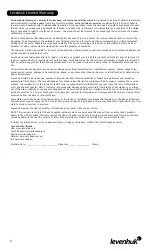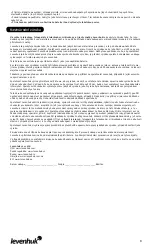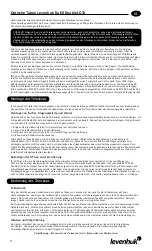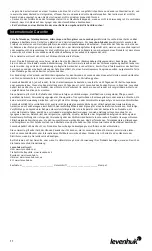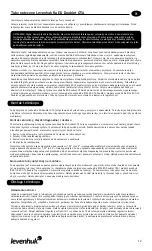
3
Telescope assembly
EN
Levenhuk Ra ED Doublet OTA
Congratulations on your purchase of a high-quality Levenhuk telescope!
These instructions will help you set up, properly use, and care for your telescope. Please read them thoroughly before getting
started.
All parts of the telescope will arrive in one box. Be careful when unpacking it. We recommend keeping the original shipping con-
tainers. In the event that the telescope needs to be shipped to another location, having the proper shipping containers will help
ensure that your telescope survives the journey intact. Make sure all the parts are present in the packaging. Be sure to check the
box carefully, as some parts are small. No tools are needed other than those provided. All screws should be tightened securely to
eliminate flexing and wobbling, but be careful not to overtighten them, as that may strip the threads.
During assembly (and anytime, for that matter), do not touch the surfaces of the optical elements with your fingers. The optical
surfaces have delicate coatings on them that can easily be damaged if touched. Never remove lenses from their housing, or the
product warranty will be null and void.
Your new OTA has an extremely fast focal ratio that makes it perfect for wide-field astrophotography, yet it still produces
breathtaking views during visual observations. All optical elements are made of high-quality ED glass with extra-low dispersion
and are fully multi-coated for crystal clear and sharp views across the field of view with no chromatic aberration. Levenhuk Ra
ED Doublet OTAs may be attached to any mount with mounting brackets (quick-release screw connectors). Levenhuk Ra R120 ED
Doublet OTA is fitted with tube rings for this purpose, Levenhuk Ra R110 ED Doublet OTA – with tube rings and dovetail mount.
The 80-mm OTAs may be mounted on a photo tripod.
CAUTION! Never look directly at the Sun – even for an instant – through your telescope or finderscope without a professionally
made solar filter that completely covers the front of the instrument, or permanent eye damage may result. To avoid damage
to the internal parts of your telescope, make sure the front end of the finderscope is covered with aluminum foil or another
non-transparent material. Children should use the telescope under adult supervision only.
EN
Your new Levenhuk Ra ED Doublet OTA is ready for observations right out of the box. This user guide will provide useful informa-
tion on assembling your optical tube and various accessories, so that you can begin your journey through the celestial sphere
with ease
Finderscope, star diagonal and eyepiece assembly
Levenhuk Ra ED Doublet optical tubes do not include a finderscope or eyepieces in their standard kit, giving you great versatility
in customizing the instrument to your needs. However, certain rules for using accessories still apply. Assembling a finderscope is
very simple:
1. Attach the base (not available in the package) onto the optical tube
2. Loosen the thumbscrew on the base
3. Install the finderscope (not available in the package) onto the base
4. Retighten the thumbscrew
All optical tubes accept 2” accessories (some models may require the use of a corresponding adapter with 1.25” or 2” acces-
sories). Keep in mind, however, that your views will be out of focus without a star diagonal or an extension ring. To install a star
diagonal or an extension tube, simply loosen the thumbscrew on the side of the focuser, insert the accessory, and retighten the
thumbscrew. Afterward, you can insert the desired eyepiece into the already attached star diagonal or extension ring.
Attaching the OTA to a mount
Your OTA is fitted with a mounting bracket (quick-release screw connectors) that may be used to attach the optical tube to a
mount or to another OTA as a guidescope (for the same purpose Levenhuk Ra R120 ED Doublet OTA is fitted with tube rings,
Levenhuk Ra R110 ED Doublet OTA – with tube rings and dovetail mount.). Once you have attached your optical tube to a mount,
you might have to balance the assembly. Loosen the ring clamps and slide the optical tube forward or backward within the tube
rings to balance it. Do not forget to retighten the ring clamps afterward.
Focusing
During celestial observations, out-of-focus images of dim stars may be very diffuse, making it difficult to focus on such objects.
Choose a brighter celestial body (such as the Moon) as your first observation object, and focus your view. With a 10:1 fine focus
adjustment (meaning that 10 turns of the fine focus knob equal 1 turn of the coarse focus knob), you can adjust the focus of your
view with great precision. Use the coarse focus knob to adjust the view until your object is as close to focus as possible, and then
make fine adjustments with the fine focus knob.
Eyepieces and magnification
An eyepiece magnifies the image produced by the OTA. The longer the focal length, the lower the eyepiece magnification, and
vice versa. Therefore, it is recommended to have several eyepieces in your equipment. The total power of the telescope setup
may be calculated with the following formula:
Magnification = Focal Length of Telescope (mm) / Focal Length of Eyepiece (mm)
Keep in mind that every telescope has a practical power limit of 1.5–2D (D is the aperture of the telescope in mm). At higher
powers, an image will always be dimmer and less sharp; the viewing conditions (the “seeing”) may also affect the quality of re-
sulting images. It is recommended to begin observations at low magnifications (longest focal length). After you have located the
desired object, you can try switching to a high-power eyepiece, if seeing conditions permit.
Operating the telescope





